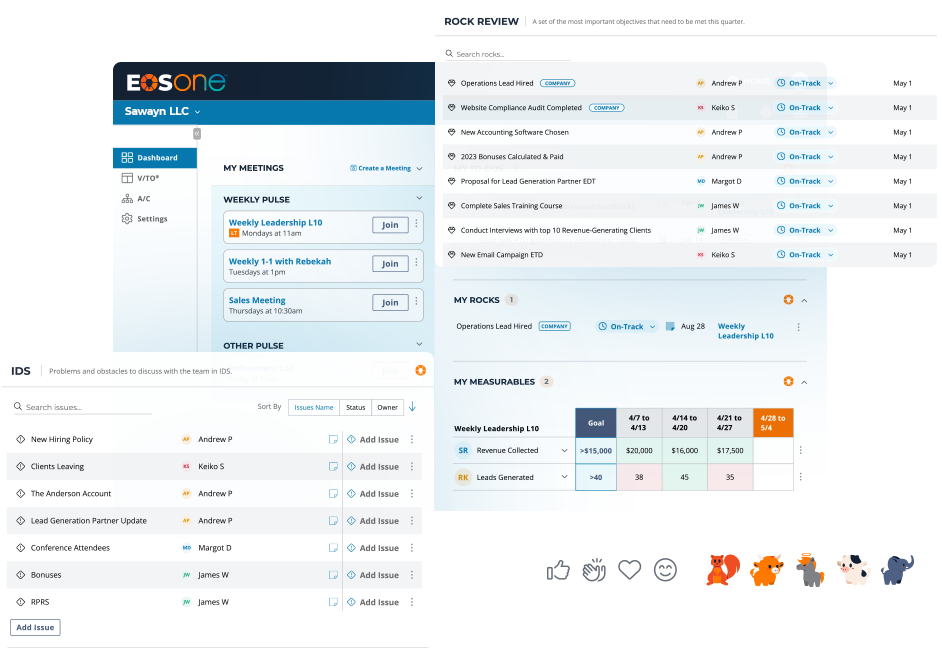As a leader, a big part of your job is to solve problems. If you think about it, that’s what you do with most of your time. When your leadership team comes together weekly, monthly and quarterly, most of the time should be devoted to resolving issues, “issues” being defined as problems, ideas or opportunities that need to be addressed, discussed and resolved.
In my experience working hands-on with 20 to 30 companies at any given time and now having delivered more than 1,600 full-day sessions with entrepreneurial leadership teams, I find that the typical entrepreneurial leadership team has between 5 and 15 issues to solve in each of its weekly Level 10 meetings and 30 to 40 issues to solve in each of its quarterly and annual planning sessions.
Some teams are great at solving their issues and get through them all, while some are terrible and are lucky to get through 25% of them.
Many years ago, to help entrepreneurial leadership teams masterfully resolve their issues, I created the Issues Solving Track, also known as IDS (this isn’t the point of this Clarity Break, but it’s important to create context—the “aha” is coming). This Issues Solving Track builds a muscle top to bottom in an organization for solving issues. Hopefully you are familiar with it and are applying it. But, just to be safe, here it is at a high level:
Once you’ve built your issues list as a team, you then prioritize the top three issues that must be solved and then launch into “IDS”:
Step 1: Identify (the I step): Dig down to the root of the issue and clearly identify what the real issue is before you start discussing anything.
Step 2: Discuss (the D step): Once you’ve identified the real issue, you now discuss all options, concerns and thoughts to resolve the issue, whether it’s a problem, opportunity or idea. Once it’s all been said, it’s time to move to step 3.
Step 3: Solve (the S step): To be a little brash here, the only reason anyone’s mouth should be moving during IDS is to get to this step. It’s all about solving stuff. Once it’s all been said, you must now decide on the best solution for the issue at hand, whether it’s a yes/no decision, a going-forward plan or a point of clarification.
For a deeper dive into understanding IDS better, read pages 131–146 in Traction.
This brings me to the point of this Clarity Break: how to save even more of the time that IDS already saves you.
Recently I had an “aha” during IDSing with a client and when I shared it with them, it saved a tremendous amount of their time and made them much better solvers. Having now tested it in the last 200 full-day sessions, this has become the most effective way to solve issues efficiently and well.
It is a very simple discipline, and it’s applied during the “I” step when identifying the issue. Here’s how it works.
As a team before diving into the issue, you must first decide “Who, Who, One Sentence.” Therefore, as you begin to identify the issue, you will quickly determine:
- Who: Who is teeing up the issue. Next, have that person say…
- Who: Who they are talking to. Almost always, there’s only one person who is ultimately accountable for that issue and its resolution. Sales issue = sales leader. Ops issue = ops leader. Leadership team issue = Integrator. Once the person identifies who they’re talking to, they direct their issue to that person, make eye contact, and say their issue in…
- One Sentence: This forces them to “rip off the band-aid” and just say it and hit the root. No more five-minute dissertations, candy coating or tip-toeing. Just open and honest direct communication.
That’s it! Who, Who, One Sentence. It’s incredibly powerful and will save hours and hours of you and your leadership team’s life. Prior to coming up with this discipline, it took the average leader five minutes to identify and state their issue. With Who, Who, One Sentence, it takes 30 seconds, tops. With 5 to 15 issues per week and 30 to 40 issues per quarter, that equals 2880 minutes or 50 hours of wasted words per year. That’s a full week of productivity per year per leader. Not to mention the continued time dancing during the discussion step because the issue is still a little unclear.
So once again, it looks like this. When you’re in the identify step of IDS, the meeting facilitator simply states, “Who’s teeing it up?” The person who’s teeing it up then says, “I’m teeing it up, I’m talking to John, and my issue is that I’m concerned about Sally: I don’t think she is in the right seat and you need to make a change.” With that level of clarity, you move to a much more productive discussion step and save time identifying and ultimately solving the issue.
Try it in your next weekly meeting. It works!
Stay Focused,
– Gino


